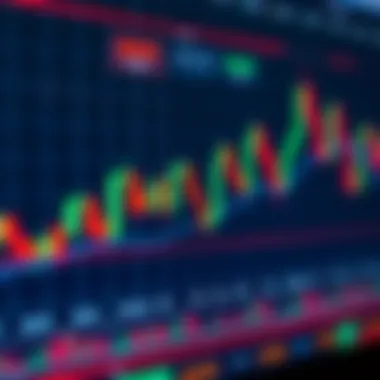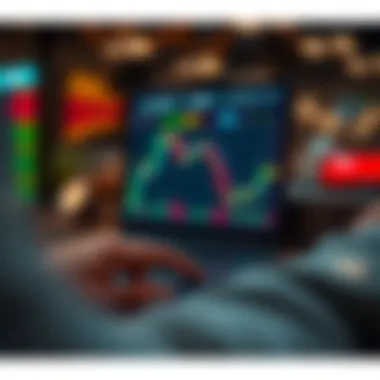Top Apps for Analyzing Candlestick Patterns in Stocks


Intro
In the world of stock trading, understanding market movements is crucial. One effective way to gauge these movements is by analyzing candlestick patterns. These graphical representations display price movements within specific time frames, allowing traders to interpret market sentiment with remarkable clarity. Thus, finding optimal applications for analyzing these patterns can significantly elevate your trading game.
As traders gear up to dive into the intricate realm of candlestick patterns, it is vital to familiarize themselves with the tools that make this analysis straightforward and effective. The best apps available not only offer robust functionalities but also cater to traders of various experience levels. In this discussion, we’ll look at how these applications can influence decision-making, enhance user experience, and tap into additional analytical tools that can provide greater insights.
In the following sections, we will explore the various attributes of top-rated candlestick analysis apps, examining their unique features, ease of use, and how they align with different trading styles. The goal is to empower traders with the knowledge to select the most suitable app that aligns with their specific needs.
Understanding Candlestick Analysis
Candlestick analysis is more than just a routine. It serves as a window into the market's emotional state and can often predict potential price movements. Each candlestick displays four critical pieces of information: the opening price, closing price, high, and low for a given time period. Familiarity with these aspects helps traders interpret patterns, making it easier to understand market dynamics.
Common Candlestick Patterns
Several patterns are recognized for their predictive capabilities. Knowing these can enhance your analytical prowess:
- Doji: Indicates indecision in the market.
- Hammer: Suggests a potential bullish reversal after a downtrend.
- Shooting Star: Signals a potential bearish reversal following an uptrend.
Each pattern conveys insights into potential future price actions, assisting traders in making informed decisions.
Key Features of Candlestick Analysis Apps
When selecting a candlestick analysis application, traders should consider specific features that enhance usability and effectiveness. Here are critical aspects to keep an eye on:
- User interface: Intuitive design can lead to more productive trades.
- Real-time data: Access to live market data keeps you ahead.
- Historical data: Examining past patterns is crucial to forecast future movements.
- Integration with other tools: Apps that combine candlestick analysis with technical indicators can provide deeper insights.
"The right app transforms data into actionable insights and a robust trading strategy."
Selecting the Right App for Your Needs
Different trading styles require different analytical approaches. Hence, the selection of an app is not a one-size-fits-all situation. Assessing your own strategy is vital—are you a day trader seeking rapid insights, or a long-term investor looking for broader trends? Knowing your preferences will guide you towards the ideal application that meets your analytical expectations.
Tips for Choosing the Right App
- Trial versions: Many apps offer free trials or demo versions. Use them to gauge usability.
- Reviews and ratings: Checking forums like reddit.com can provide insights from other traders.
- Customer support: Reliable support can enhance user experience, especially for those new to trading.
As we delve deeper into the various applications available in the market, we'll highlight those that stand out in terms of features, ease of use, and overall effectiveness in candlestick analysis. By equipping yourself with the right tools, you lay the groundwork for making well-informed trading decisions.
Understanding Candlestick Charts
Candlestick charts play a foundational role in analyzing stock market trends. They not only convey essential price information but also tell a story about the market's movements over a given time period. Understanding these charts is crucial for traders and investors who aim to make informed decisions based on historical price data. Candlestick patterns can reveal potential market reversals or continuations, which are pivotal in determining entry and exit points for trades.
When approaching candlestick charts, it's important to grasp a few key elements that underpin their effectiveness. For instance, one learns to associate certain shapes and formations with specific market behavior. A well-formed candlestick can suggest whether buyers or sellers dominate the market during a specific timeframe, thereby enabling traders to better assess potential price actions.
Basics of Candlestick Patterns
Candlestick patterns are typically composed of a body and wicks (shadows). The body represents the opening and closing prices, while the wicks indicate the high and low prices within a set time frame. Traders often categorize these patterns into bullish and bearish formations.
For example, a long green (or white) body suggests strong buying pressure, often signaling an upward trend, whereas a long red (or black) body implies selling pressure, indicating a possible downtrend. Common patterns like the Hammer, Shooting Star, and Engulfing Pattern further illustrate the battle between buyer and seller sentiment. Knowing these basics allows investors to draw meaningful conclusions from past price actions, which is vital for future trading decisions.
Key Components of a Candlestick
To properly interpret candlestick patterns, one must consider several components:
- Open price: The price at which the asset started trading in the given timeframe.
- Close price: The final price at the end of that timeframe.
- High price: The maximum price reached during the time interval.
- Low price: The minimum price achieved in the same period.
Each component contributes to the overall picture of market sentiment and dynamics. Traders who can read these components accurately can develop strategies that reflect broader market trends. This deep awareness often distinguishes successful traders from those who merely follow the crowd.
Importance in Stock Trading
Understanding candlestick charts is not merely academic; it holds immense practical value. A solid grasp of these tools empowers traders to identify patterns that may indicate upcoming price shifts. Such foresight can be the difference between profiting from a trade and taking a loss.
Investors often reference candlestick patterns when determining their strategies. Whether in day trading or long-term investing, these visual cues can guide decisions and help manage risk more effectively. Moreover, they can integrate well with other numerical indicators, providing a layered approach to analysis.
"Most successful traders use candlestick patterns as their primary form of technical analysis. Their ability to help in predicting market direction has made them indispensable tools for decision-making."


In summary, the importance of understanding candlestick charts extends beyond their visual appeal. They serve as critical instruments in the trader's toolkit, offering insights that can lead to more nuanced strategies. Grasping their basics lays the foundation for more complex analyses, enabling investors to navigate the stock market with greater confidence.
The Role of Technology in Trading
In today’s fast-paced financial landscape, technology shapes how traders make decisions and analyze trends. The evolution of trading technology has brought significant changes, giving investors tools that were once considered science fiction. The importance of technology in trading can’t be overstated; it enhances efficiency, accuracy, and accessibility. Without it, trading would likely revert to the slower, manual processes of the past, which were riddled with human error and inefficiencies.
Evolution of Trading Apps
Trading apps have come a long way since their inception. Initially, they were basic tools that offered limited functionalities, primarily focused on stock price tracking. Over time, the demand for real-time data and robust analytical capabilities led to the development of advanced applications.
For example, platforms like E*TRADE and TD Ameritrade stand out, not just for their trading capabilities but also for their rich features that help traders analyze patterns, such as candlestick charts. These apps have continually adapted to incorporate user feedback and the latest technological advancements, ensuring they meet the evolving needs of traders.
The introduction of algorithmic trading and automated features also altered the way trades are executed. Traders can now set parameters, and the apps will execute orders based on market conditions without manual input, greatly enhancing trading efficiency.
Mobile Access and Its Importance
Gone are the days when trading was confined to a desktop setup. With the rise of smartphones and tablets, accessing trading apps on the go has become the norm. This mobile access provides traders with the flexibility to monitor the market in real-time, whether they're commuting, taking a lunch break, or even on vacation. According to a recent survey by Statista, 72% of traders prefer using mobile devices for trading-related activities.
The immediacy of mobile access means that traders can respond to market changes as they happen, giving them a competitive edge. This instantaneous nature of trading reduces the likelihood of missing out on potential opportunities, allowing users to capitalize on favorable market conditions without delay.
Data Analysis at Your Fingertips
One of the immense benefits of trading apps is the wealth of data analysis features they offer. Today’s applications provide users with a plethora of tools to interpret market data at a glance. From advanced charting options that display candlestick patterns to sophisticated algorithms that analyze historical data, the options are seemingly endless.
"Having an arsenal of analytical tools makes all the difference in stock trading. The right app can literally transform how you perceive and react in the market."
For instance, apps like Robinhood and Webull allow users to build personalized watchlists and receive alerts for specific candlestick patterns, empowering traders to make informed decisions quickly. Access to aggregated market data and customizable indicators further enriches the analysis experience, making it easier for traders to spot trends that inform their investment strategies.
Moreover, the integration of machine learning algorithms enhances data predictions, offering insights that were unattainable even a decade ago. As technology continues to advance, traders will have increasingly sophisticated data analysis tools to refine their strategies and improve their decision-making process.
In summary, the role of technology in trading cannot be underestimated. It serves as the backbone of contemporary trading, making strategies more comprehensive and responsive to market dynamics. As we delve deeper into the capabilities of specific candlestick stock applications, understanding this role lays a critical foundation for assessing their utility and effectiveness in real-time trading scenarios.
Top Candlestick Charting Applications
Understanding the various candlestick charting applications is crucial for any trader aiming to enhance their trading skills. These apps serve as essential tools that allow traders to analyze stock patterns effectively. Not only do they provide graphical representations of market activity, but they also come loaded with features that aid in decision making. Each application offers unique benefits that can cater to different trading styles, from casual investors to seasoned professionals. This section delves into the critical aspects of leading charting applications, guiding users in identifying which tools best suit their needs.
Features of Leading Apps
When it comes to features, candlestick charting apps vary widely. Most applications include standard candlestick charts, but beyond that, traders should look for specific functionalities that can make a significant difference in their trading experience. Here are some common features to consider:
- Real-Time Data Access: The ability to view stock data in real-time is pivotal. This ensures that traders are making decisions based on the latest information.
- Customizable Charting Options: A good app should allow users to customize charts, including colors, time frames, and technical indicators. Personalization can vastly enhance clarity when observing trends.
- Technical Indicators: Integration of indicators like Moving Averages, Bollinger Bands, or Relative Strength Index (RSI) can provide deeper insight into market behavior.
- Backtesting Capabilities: The ability to test strategies using historical data gives traders a chance to evaluate their approaches before risking real money.
User Experience and Interface Design
A well-designed user interface can be the difference between a productive trading session and a frustrating one. App developers focus on user experience by ensuring that navigation is intuitive and straightforward. This simplicity helps traders access key data without unnecessary complexity. Here are several elements that enhance user experience:
- Ease of Navigation: Users should find the app easy to navigate, allowing them to move seamlessly through different charting tools and features.
- Responsive Design: Apps need to perform well on various devices, whether they are being accessed on a smartphone, tablet, or desktop. A responsive design ensures functionality across platforms.
- Visual Clarity: The layout should prioritize clarity, making it easy to interpret data without eye strain. Bright colors against dark backgrounds, for instance, can enhance visibility without being distracting.
Integration with Other Tools
Many traders utilize a collection of tools for market analysis. The best candlestick charting applications seamlessly integrate with other financial tools, allowing for an efficient workflow. This integration may include:
- News Aggregators: An application that links to market news helps traders stay informed about events that may influence stock prices.
- Trading Platforms: An integrated trading platform can simplify executing trades directly from the charting app without switching between different applications.
- Social Media Feeds: Some applications now incorporate user-generated insights from platforms like Reddit or Twitter, adding a community aspect to stock analysis.
In summary, selecting a powerful candlestick charting application goes far beyond just picking one with the right charts. Traders must weigh various features, user experience, and the ability to integrate with other analytical tools. With the right application at their fingertips, traders can enhance their understanding and responsiveness to market conditions.
Criteria for Choosing a Candlestick Stock App
When it comes to navigating the bustling world of stock trading, having the right tools at your fingertips can make all the difference. Choosing an app for analyzing candlestick stock patterns involves a careful assessment of several key factors. It’s not just about picking the flashiest option on the market, but rather finding the one that aligns perfectly with your trading approach and personal needs.
Assessing User Needs
Every trader has unique requirements based on their experience level, trading style, and investment goals. To start on the right foot, it’s essential to ask yourself: what do I want from this app? Do you need advanced features like backtesting capabilities, or are you looking for something straightforward that displays live market data?
- Beginner Needs: If you’re new to the scene, seek simplicity. User-friendly designs and educational resources, like tutorials or webinars, can be tremendously helpful.
- Intermediate to Advanced Needs: More seasoned traders might be interested in features such as technical indicators, chart overlays, or even automated alerts that highlight specific candlestick patterns.


Remember: The best app is one that caters to your personal style while also challenging you to grow as a trader.
Evaluating Security Features
In a landscape rife with cyber threats, security cannot be an afterthought. Your chosen app should prioritize the protection of your trading information and funds. Here are some points to keep in mind:
- Encryption Protocols: Look for apps that utilize advanced encryption methods to safeguard your data.
- Two-Factor Authentication: This adds an extra layer of security, ensuring that even if someone gets your password, they still can’t access your account without another verification step.
- Regulatory Compliance: Select an app that complies with regulations from entities like the SEC or appropriate financial authorities in your region, which can help protect you from fraud.
"A secure app is not simply a luxury; it’s a necessity in trading."
Cost and Subscription Models
Let’s face it: while some apps boast a plethora of features, those bells and whistles often come at a price. Therefore, before pulling the trigger, analyze the financial aspect carefully. Here are some considerations:
- Free vs. Paid Apps: There are solid free options with essential features, but paid versions usually offer more robust tools. Consider what features are essential for your trading style and whether they justify the cost.
- Subscription Models: Some apps use monthly or yearly subscriptions. Sometimes, committing to a long-term plan can save you money in the long run, but ensure it aligns with your trading commitment.
- Trial Periods: Many qualified apps offer free trials. Utilize these to assess whether the app’s features and user interface meet your expectations before subscribing.
In the end, selecting a candlestick stock app isn’t a one-size-fits-all scenario. By carefully assessing your needs, examining security measures, and evaluating costs, you’ll be positioning yourself for more informed trades and a better overall experience in the stock market.
Comparative Analysis of Popular Apps
The landscape of stock trading apps is vibrant and ever-evolving. A comparative analysis of popular apps can be a game-changer for traders and investors who rely on candlestick patterns for their strategies. This analysis sheds light on critical aspects such as features, usability, performance, and overall value. By scrutinizing various applications side by side, traders can make informed decisions that align with their trading needs and preferences.
When delving into a comparative analysis, it’s essential to focus on the practical benefits these apps offer. For instance, beyond just looking at the basic functionalities, one might consider the learning curves, customer support, and how each app integrates with existing stock markets or personal investment strategies. Comprehensive comparisons allow investors to weigh their options and find the symmetry that best fits their trading style.
App A vs. App B
In evaluating App A and App B, both have carved out their niches in the stock trading arena. App A, known for its intuitive interface and user-friendly design, allows traders to navigate charts with ease. Its standout feature is the real-time data feed, which keeps users updated on market trends without delay. Moreover, the inclusion of advanced technical indicators enhances its analytical capabilities.
On the flip side, App B shines in its customization options. Traders can tailor the indicators and even set price alerts for specific candlestick formations. This feature caters particularly well to those who prefer a hands-on approach to their trading strategies. However, some users have reported that the interface can be a bit cluttered, especially for beginners.
"Navigating through a sea of tools can be overwhelming; one needs to find what works best for their trading style."
App vs. App
When we step into the comparison of App C and App D, the differentiation in targeting user needs becomes clearer. App C is often praised for its educational resources, which can elevate novice traders. With detailed tutorials on interpreting candlestick patterns and market behaviors, this app provides not just tools for trading but also knowledge for making more informed decisions.
Conversely, App D leans heavily on social trading features. It facilitates interaction among users, enabling them to share strategies and insights. For those who enjoy community engagement, this offers an invaluable layer of learning through shared experiences. However, the reliance on peer advice can sometimes lead to conflicting strategies, and thus, caution is advisable.
User Reviews and Ratings
User feedback is a crucial element in evaluating stock trading applications. Reviews can reveal the true strengths and weaknesses of each app, often uncovering aspects that comparisons might miss. Here are some observations based on user ratings:
- Users of App A frequently highlight the app’s simple navigation, although there are occasional complaints about the lack of depth in technical analysis tools.
- User reviews on App B celebrate its comprehensive features, albeit some find the onboarding process somewhat confusing initially.
- Comments about App C often point out its excellent customer service and extensive educational materials, making it a favorite among beginners.
- Users of App D appreciate the community aspects but advise potential users to remain discerning about the advice they receive.
Ultimately, sitting back and taking the time to sift through actual user experiences can provide insights that developer descriptions often gloss over. Interested individuals are encouraged to visit forums like Reddit for real-world discussions and reviews about these applications. By doing so, they can gather well-rounded perspectives that help guide their choices.
Additional Functions of Stock Apps
The role of stock trading applications in today's fast-paced markets keeps evolving. Beyond merely offering candlestick charts, these apps include vital functions that can significantly impact trading success. As traders and investors, recognizing the additional functions in stock apps allows one to employ them as tools that enhance analytical capabilities and streamline decision-making processes.
Market News and Updates
Staying abreast of market news is critical in trading. Candlestick patterns can provide insights into price movements, but without real-time information, traders may miss essential signals. Reliable stock apps provide direct access to market news and updates, ensuring that the user is informed about economic indicators, market analysis, and other news that could affect stock prices. This kind of news is not just about the headlines; it often includes nuanced analysis that can help traders make sense of market shifts.
For instance, if a trader is monitoring a particular stock and receives an alert about a major acquisition related to that stock, the trader can then adjust their candlestick analysis accordingly. Also, having access to earnings reports and market sentiment data can enhance the trader’s understanding of potential future price patterns.
Why It Matters:
- Timeliness: Quick access to breaking news can be the difference between profit and loss.
- Comprehensive Analysis: Integrating news with candlestick patterns creates a more rounded view of market activity.
- Active Engagement: Users feel more in control and empowered to make informed decisions, leading to a more engaged trading experience.
Alerts and Notifications
The trading landscape can be rife with unexpected movements, making timely notifications a strong asset. Many advanced trading apps offer customizable alerts for price changes, market events, and even when technical indicators reach certain levels.
Imagine a trader who's focusing on a stock that’s traditionally volatile. The ability to set specific alerts for price fluctuations or even candlestick formations creates a responsive environment. When a trader receives immediate notification about a breaching support level or a bullish engulfing candle, they can react swiftly, minimizing potential losses or capitalizing on opportunities.


"In the world of trading, timely information can be worth its weight in gold."
Key Benefits of Alerts:
- Real-Time Updates: Immediate alerts on significant price movements enhance responsiveness.
- Customizability: Users can tailor alerts based on their trading strategies and risk tolerances.
- Proactive Trading: Being notified allows traders to act rather than react, optimizing their strategies.
Community Features and Interaction
Stock trading is not just an individual endeavor; it thrives on interaction and shared knowledge. Community features in trading apps can foster conversations among traders about techniques, strategies, and personal experiences regarding candlestick patterns. These features often include forums, chat rooms, or integrated social media functionalities.
A trader who can share insights or questions with fellow users gains valuable real-world knowledge. Viewing successful trades or learning about mistakes helps refine strategies and build confidence. Additionally, these community-driven aspects of trading apps can reveal emerging trends or lesser-known patterns that may not yet be widely recognized.
Advantages of Community Interaction:
- Peer Support: Engaging with others can help solidify concepts and encourage new ideas.
- Information Exchange: Users can share unique insights that complement the technical analysis done through candlestick charts.
- Networking Opportunities: Connecting with other traders can lead to mentorship or partnerships that enhance one’s trading journey.
By leveraging these additional functions of stock apps, traders can cultivate a more informed, proactive, and engaged trading style. As the stock trading environment grows ever more complex and interconnected, it is essential to maximize these tools for optimal success.
Future Trends in Stock Trading Applications
The landscape of stock trading applications is shifting faster than a stock price on a volatile day. Understanding these trends is essential for any trader looking to stay ahead of the curve. Factors such as technology, user behavior, and regulatory landscapes converge to shape the future of trading apps.
Artificial Intelligence in Trading Apps
Artificial Intelligence (AI) is not merely a buzzword anymore; it’s making waves across the financial sector. Using AI, trading apps can now analyze massive datasets in real-time, providing insights that were previously impossible to achieve for the average trader.
For example, AI algorithms can identify patterns from historical data to make predictions about future trajectories of stocks. These prediction models are sophisticated enough to adjust continuously, learning from market changes and trader behaviors. Consequently, they often outperform traditional methods that rely solely on manual analysis.
Traders leveraging AI in their applications gain a significant edge, as these tools can signal ideal entry and exit points based on comprehensive analyses of candlestick patterns, market sentiment, and even news events. This capability not only augments decision-making but also minimizes human errors that may arise from emotional trading.
"With AI tools, trading becomes more science than art, allowing for data-driven decisions to mitigate risks."
Enhanced User Interfaces
The competitive nature of stock trading apps compels developers to prioritize user experience. Intuitive design is not just fluff; it’s a necessity. Modern interfaces are becoming increasingly pragmatic, enabling traders to interact seamlessly with complex data points. Features like customizable dashboards, interactive charts, and simplified trade execution are now standard expectations.
A user-friendly interface allows both novice and experienced traders to engage effectively without getting lost in a maze of jargon and clutter. Tools such as swipe gestures for quick trades, voice commands, or even augmented reality features are being explored in some cutting-edge applications. These enhancements remove barriers for users and facilitate a more fluid trading experience. The clearer your interface, the quicker your trades, and this is crucial in fast-moving markets.
Potential Regulatory Changes
As with any financial service, trading applications must navigate the labyrinth of regulations that govern market interactions. With technology evolving at a breakneck speed, regulatory bodies scramble to keep pace. Potential regulatory changes can have profound impacts on the functionalities of trading apps and the overall market environment.
For instance, regulations aiming to safeguard data privacy may restrict how apps collect and utilize trader information, while fiduciary standards might alter how tips and insights are presented to users. Keeping an eye on these potential changes is imperative for traders to adapt their strategies accordingly.
Traders must also remain informed about regulations that affect high-frequency trading, algorithmic trading, and user protections. As the market landscape shifts, so too will the tools and applications we use. Staying informed can mean the difference between being ahead of the game or left in the dust.
In summary, keeping a close watch on these trends not only equips traders with the tools needed to adapt but also primes them for opportunities that can enhance their trading journey.
Ending
Navigating the world of stock trading is no small feat, especially with the dizzying array of options available in today’s market. Choosing the right application for analyzing candlestick stock patterns emerges as a crucial step for traders seeking to make informed decisions. This article has underscored the key attributes to consider in such applications, including user interface, analytical features, and integration with other tools.
Final Thoughts on Choosing the Right App
Selecting a stock trading app isn’t just a matter of picking the first one that pops up in a search engine. Traders should reflect on their unique-strategies and how each app aligns with their plans.
- Usability: An app that’s intuitive can save you time and confusion. Check out user feedback and ratings to gauge how intuitive an app is.
- Analytical Tools: Look for apps that offer advanced charting features and technical indicators useful for candlestick analysis. A feature-rich app empowers traders to make data-driven decisions effectively.
- Reliability: Stability and less downtime are essential in trading. Opt for apps with a solid reputation regarding performance.
- Customer Support: In the ever-changing landscape of stock trading, prompt support can be a lifesaver. Ensure that the app offers reliable customer service options.
Taking the time to weigh these factors can spell the difference between seeing gains over time or hitting a brick wall.
Empowering Traders with Technology
In an industry where every second counts, technology plays a vital role in enabling traders to stay ahead of the curve. The integration of cutting-edge features—like real-time data feeds and customizable charts—helps traders respond to market shifts promptly.
"Technology isn’t just a tool; it's a partner in your trading journey."
Embracing the technological advancements in stock trading apps allows traders not only to analyze candlestick patterns effectively but also to engage with broader functionalities like market news updates and community forums.
Moreover, with the rise of artificial intelligence and machine learning within these applications, traders can leverage predictive analytics that enhance decision-making capabilities through deeper insights into market trends. Investing in the right technology today equips traders with a robust foundation for navigating future market uncertainties.
For more insights on trading strategies and tools, check resources like Investopedia or MarketWatch.



